Delightful Provincial Cambodia 10 – Bassac River Road 1 (Kandal Province)
Whenever I looked at a Cambodian map, since my very first visit to the crumbling Kingdom in 2000, the Bassac river road caught my attention. Just south of Phnom Penh, Bassac river branches off mighty Mekong and meanders on its own trip down south in very elegant curves, until it reaches Vietnam with the bustling riverine community of Chau Doc. And hugging the western shore of this winding river, highway 21 snakes down from near Phnom Penh through the small towns of S'ang and Koh Thom, then on to the Vietnamese border and beyond. It's a small road right on the river, and the border is not open to westerners – seemingly the ideal setting for a day of lazy local pothole research.
Only in March 2006 I get a good chance to explore the Bassac river road: Norah, my Khmer partner is with me and looking forward to a countryside trip; generous Khmer friends lend us their jeep one more time; and in Matt Jacobson's "Adventure Cambodia" I had discovered a favorable review of the road. Without any breakfast, we hurry to set out for Bassac river road at 7.00 a.m. – but it is already too hot.
In Phnom Penh, you drive south on Monivong Boulevard past the highly protected Japanese embassy. Next on the left side comes the Thai embassy that I had seen burnt by mindless remote-controlled Cambodians in January 2003; a little later you pass the gate of the delightful "Jardins du Bassac", a complex with expensive pseudo-mediterranean serviced apartments and swimmingpool plus garden right on Bassac river – plus very poor Khmer fishermen's huts close by.
Then it's the traffic circle next to Monivong Bridge. Khmers drive around this circle in eight to 18 lanes. To get into the flow with a car, you proceed millimeter by millimeter with many stops. Next to you stand other cars pointing in all directions, unable to proceed, as motorcycles and bicycles shoot around mercilessly from all sides, and of course no one gives way. Once you're in the mainstream, you can move on with a whopping three mph – until you want to weave out again, which is another fight for micrometers.
— INTO TAKMAO —
Finally you are in Takmao town. The bridge there is broken, because you're in Cambodia. They've built a dirt dam next to the bridge, so we bump along the ridge. Then we arrive at Bassac river promenade – and suddenly all the stresses and rigours of Phnom Penh evaporate. This is a large dilapidated riverside, with just few people. It is easy to find shady parking. Under shady trees we sit down on the ubiquituous blue plastic chairs for a first "breakfast" – fresh coconut juice and grilled corn cobs. There's a delightful breeze from the river, and a few other Khmers concentrate on noodles and sugar cane juice.
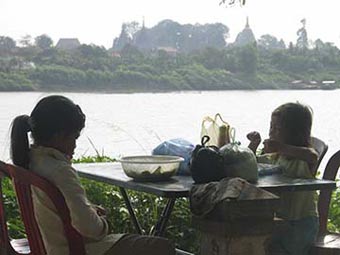
|
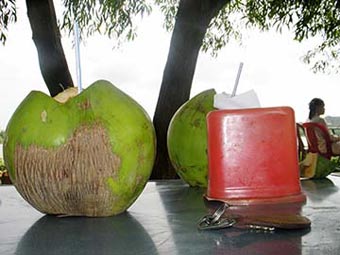
|
I stroll along the shady promenade. Next to a teachers college young Khmers in white shirts eye me curiously; there are a few colonial buildings, and all in all it has that delightful slow provincial Cambodian feeling that you may also experience in local capitals such as Kampot (now getting too touristy) or Svay Rieng.
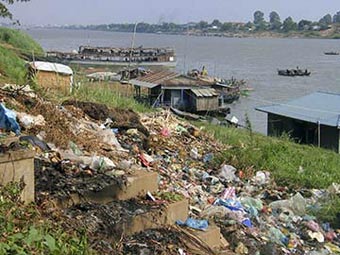
|
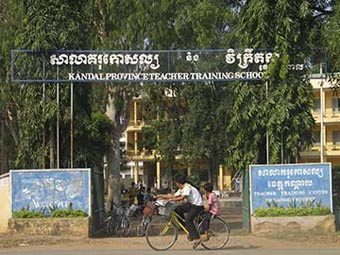
|
Back on my blue plastic chair, I muse to Norah: "Hm, how about living in quiet Takmao with a breeze from Bassac river, and commute to Phnom Penh by boat?" Norah smiles: "You can get a good boat for just 1000 dollars". There's no market niche she hasn't explored. We dream a little more, slurp coconut juice and then call for "khut loy" – we want to pay.
We continue on a rough, dusty dirt piste. Mostly small wooden houses block the river view. Near a market there is a high cement wall that stretches on for hundreds of meters; out of a gate, clouds of people in white shirt and blue trousers spill onto the dust road. "What a big and strong school here in the outbacks", I comment to Norah. – "This is a factory, darling."
— THE OTHER SHORE–
A little wooden passenger boat sets off to the other, eastern riverside. They offer to put the car right onto the shaky construction, but that stretches our confidence too far. Anyway, we would like to set over for a look. The family next to the diminutive pier has a bare vegetable field behind the house. We ask if we may park there; they say we could steer the car to the front of their house, right in front of their open living room and bamboo platform, where they could better watch it.
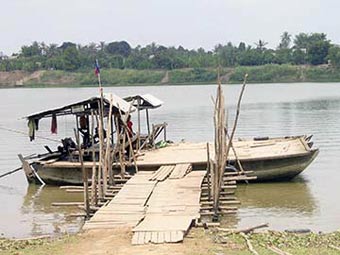
|
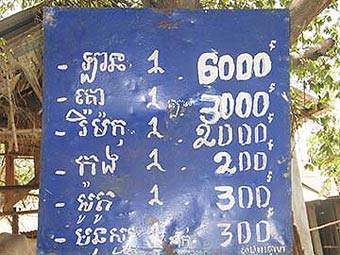
|
The ten-minutes crossriver boat ride costs 300 riels per person, about 8 US cents. The people on the other side welcome us with big Hellos – rarely has a Barrang (westerner) set foot on this shore. This side of Bassac river is even more remote and difficult to reach than the western side with our road.
The sun blasts down and Norah has little interest to walk around between farmers' huts. But we learn there is a market two kilometers away, and they have "takalok", Khmer style fruit smoothies. Soon a motodup is found, a motorcycle taxi, and we bounce off, three people on a wrecked Korean Daelim.
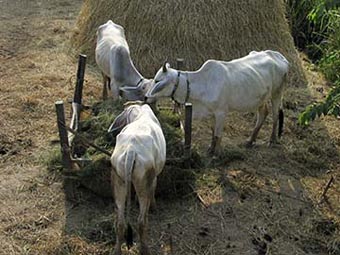
|
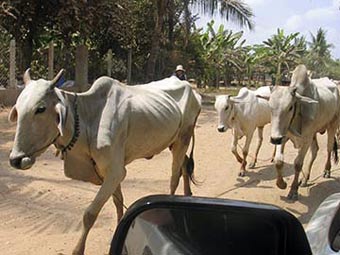
|
We slalom between wooden family homes on low stilts, cut through a pagoda court and reach a wobbly inter-village dirt road. Quite notably, all houses here have several white cows around them, munching dried grass from shaded bamboo boxes. I never saw people caring so much for their cows; and I never saw tropical cows looking more healthy and fresh. Soon Norah has learnt from the motodup that people here make a living from raising cows, even the Viets arrive for bovine shopping. A calf sells for 7- to 800 US dollars, grown-ups start from 1000 US dollars. The real supercows fetch as much as 3- or 4000 dollars.
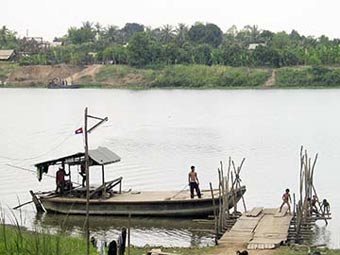
|
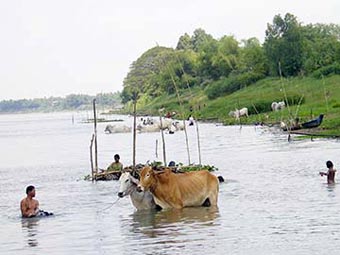
|
As we bump down the village roads with prosperous wooden family homes and attached front-yard cows, we can't help but calculate the wealth each family here has collected in cloven-hoofed assets. The actual village market itself is boring, the takalok stall has not yet opened, and 15 minutes later we are back at the boat pier. Here, many white cows receive a shower, and dark brown kids splash happily in the water. For the western hobby photographer, they put on an extra show; nobody has taught them to ask for money.
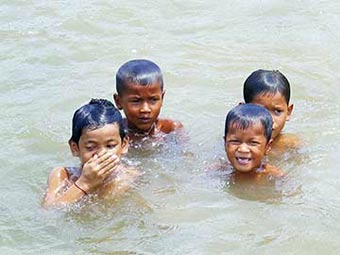
|
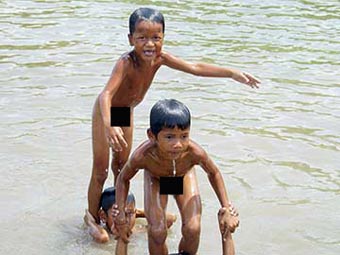
|
Norah translates the passenger fee list to me: 6000 riels for a car, 3000 riels per cow. Then she chats for a while with an elderly man, until she translates: "Some years ago, a western man married a Khmer lady three villages downriver. He says the westerner looked very good in his Khmer wedding dress!" Hint, hint.
Back on the other side, we say "awkhun cheran", thank you, to the family who watched our car. Norah gives them two lukewarm cans of coke we once received for free at a gas station. She says coke's better than money as a sign of appreciation.
— INCIDENT–
When I try to manoeuver the car backwards onto the road, suddenly I see a guy talking to me angrily from outside. His face looks enraged. Obviously with the cargo bed of our pickup I've hit the decrepit wooden post that holds the sign for the ferry service. I step out and see that the pole has suffered a bit, but I don't even know how much of that is my fault. They could continue to use the pole without any repair. I figure that five dollars might take care of the situation. I say "Som tow, som tow" (sorry, sorry) and ask Norah to come out for help. Suddenly the angry man retreats to a bamboo platform with other family members. They put on ostentatiously neutral faces. Norah slowly walks out of the car and looks at the pole as if she couldn't understand the problem. Then she looks at the family with a very sweet smile: "Mee'en panyaha te?" (Is there a problem?) Everybody shakes their heads – see, there is no problem and never has been.
We go back to the cabin and disappear without further interventions.
We bounce on along dusty village roads and see at least one hundred thousand dollars worth of white tropical cows – should we kidnap one on our cargo bed? Finally we reach the asphalt road that will take us further down south towards Vietnam.
Right on the river edge, near the town of S'ang, there is a shady, but breezy food market. We settle for beef soup and lemon juice with river view and a breeze, and for the after-lunch-siesta they even have hammocks. Can pothole research in delightful southern Cambodia be any more relaxed?
Stickman's thoughts:
Only one more part to go.




